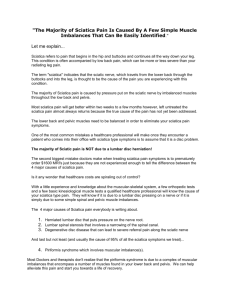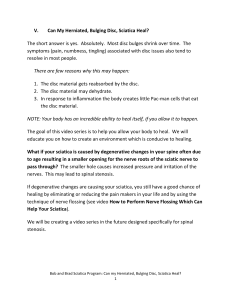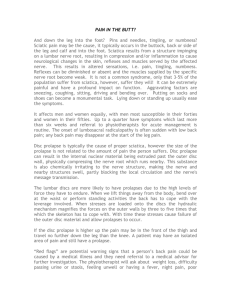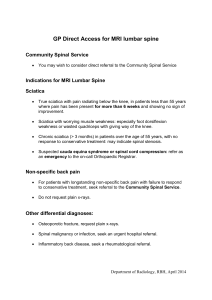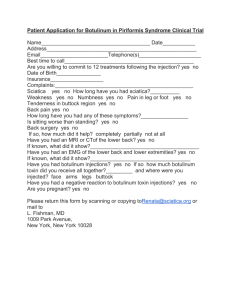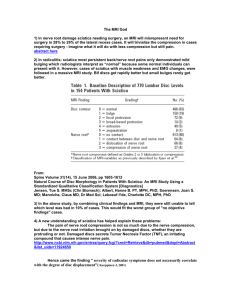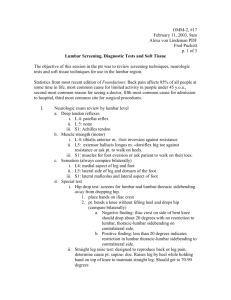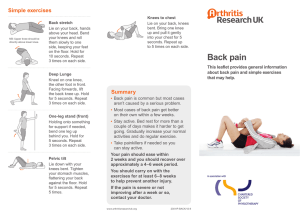Diagnosis and treatment of sciatica accepted version
advertisement
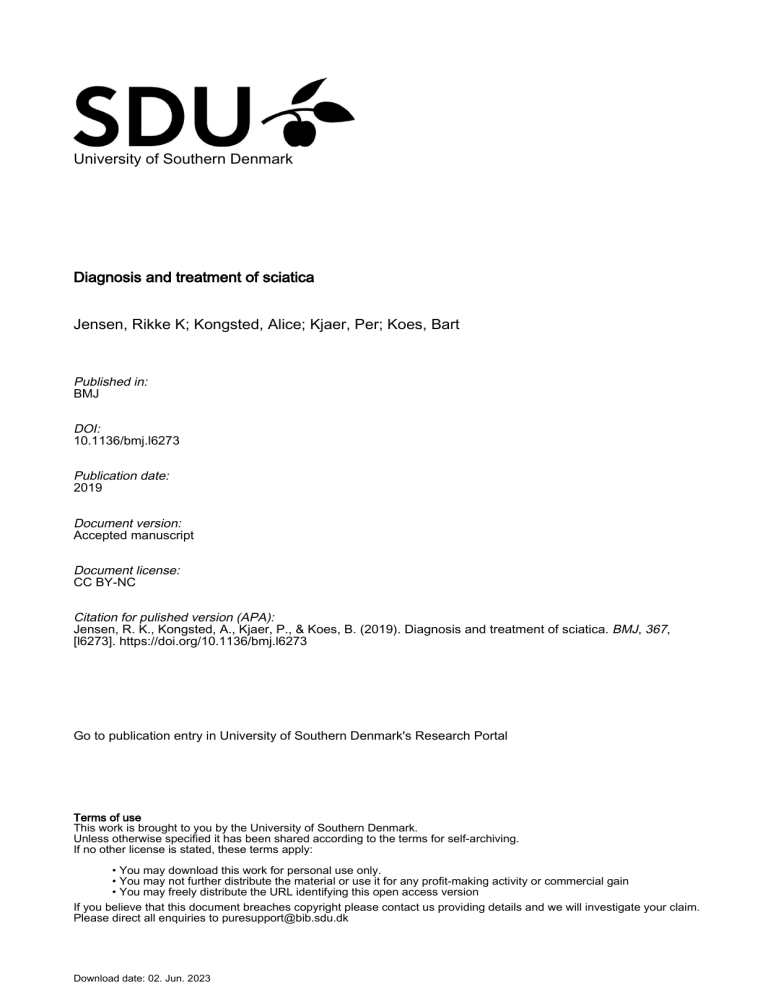
University of Southern Denmark Diagnosis and treatment of sciatica Jensen, Rikke K; Kongsted, Alice; Kjaer, Per; Koes, Bart Published in: BMJ DOI: 10.1136/bmj.l6273 Publication date: 2019 Document version: Accepted manuscript Document license: CC BY-NC Citation for pulished version (APA): Jensen, R. K., Kongsted, A., Kjaer, P., & Koes, B. (2019). Diagnosis and treatment of sciatica. BMJ, 367, [l6273]. https://doi.org/10.1136/bmj.l6273 Go to publication entry in University of Southern Denmark's Research Portal Terms of use This work is brought to you by the University of Southern Denmark. Unless otherwise specified it has been shared according to the terms for self-archiving. If no other license is stated, these terms apply: • You may download this work for personal use only. • You may not further distribute the material or use it for any profit-making activity or commercial gain • You may freely distribute the URL identifying this open access version If you believe that this document breaches copyright please contact us providing details and we will investigate your claim. Please direct all enquiries to puresupport@bib.sdu.dk Download date: 02. Jun. 2023 This article has been accepted for publication in BMJ, 2019 following peer review, and the Version of Record can be accessed online at https://doi.org/10.1136/bmj.l6273 Diagnosis and treatment of sciatica Rikke Krüger Jensen, associate professor1,2, Alice Kongsted, professor1,2, Per Kjaer, professor1,3, Bart Koes, professor1,4 Center for Muscle and Joint Health, Department of Sports Science and Clinical Biomechanics, University of Southern Denmark, Odense, Denmark 1 Nordic Institute of Chiropractic and Clinical Biomechanics, Odense, Denmark 2 Health Sciences Research Center, University College Lillebaelt, Odense, Denmark 3 Department of General Practice, Erasmus Medical Centre, Rotterdam, Netherlands 4 Radiating leg pain, commonly referred to as sciatica, can cause severe discomfort and functional limitation. It is caused by inflammation or compression of the lumbosacral nerve roots (L4-S1) forming the sciatic nerve (1). Patients may have associated low back pain (LBP). LBP with pain radiating to the leg appears to be associated with increased pain, disability, poor quality of life, and increased use of health resources compared with LBP alone, as per a systematic review (9 studies) (9). There is no clear definition of the term sciatica and it is often used inconsistently by clinicians and patients and when used as a diagnosis in research (2). It has been suggested to instead use the term radicular pain or lumbosacral radicular syndrome (3). In this article, we have used the terms sciatica and radicular pain synonymously describing leg pain caused by nerve root involvement. Radiculopathy refers to a nerve root affection causing dysfunction of the nerve including weakness or numbness. New clinical guidelines (4, 5) on diagnosis and treatment of sciatica have been published, recommending conservative treatment approaches including education and exercise and restraint toward medication and surgery. In this update, we review the epidemiology, diagnosis and treatment of sciatica in order to help clinicians provide evidence-based diagnosis and treatment for patients with sciatica. © Authors. Reuse of this manuscript version (excluding any databases, tables, diagrams, photographs and other images or illustrative material included where another copyright owner is identified) is permitted strictly pursuant to the terms of the Creative Commons Attribution-Non Commercial 4.0 International (CC-BY-NC 4.0) http://creativecommons.org. https:// creativecommons.org/licenses/by-nc/4.0. 1 How do patients present? Patients usually describe aching and a sharp leg pain radiating below the knee and into the foot and toes. (6). It can start suddenly or have a slow onset. Severity of pain can vary between patients. Most patients report co-existing LBP. Disc herniations affecting L5 or S1 nerve root are more common and cause pain at the back or side of the leg into the foot and toes. (7). If L4 root is affected, pain is localised to the front and lateral side of the thigh (6). Symptoms such as tingling or numbness can be present in the same dermatomal distribution. Some patients experience loss of muscle strength. How common is sciatica? The prevalence of sciatica varies between studies. In a UK primary care study (609 patients), about 60% of patients with back and leg pain were clinically diagnosed with sciatica (8), whereas a Danish primary care study found that 2% of patients in chiropractic clinics and 11% in general practices had neurological examination findings confirming sciatica (9). Smoking, obesity and manual labour were identified as modifiable risk factors for first-time incidence of sciatica in a recent systematic review (8 studies), suggesting the potential for prevention (10). What are the causes? Disc herniation due to age-related degenerative changes, and rarely trauma, is the commonest cause of radicular leg pain. (1, 8) (Figure 1) Foraminal stenosis and, less commonly, soft tissue stenosis due to cysts, tumours or extraspinal pathology are other causes (12). Rarely, extraspinal pathology in the lumbosacral nervous plexus such as neoplasm, trauma, infection, or gynecological conditions, or muscle entrapment such as piriformis syndrome can mimic symptoms of disc herniation (12). Compression of the nerve root and resultant inflammation play a role in pathogenesis of sciatica (1). The inflammatory response induces resorption of the herniated disc material, and is thought to be the reason why patients improve without surgery. 2 How is sciatica diagnosed? It is largely a clinical diagnosis based on patient’s symptoms findings on examination. A history of leg pain worse than back pain or pain below the knee should raise suspicion of sciatica. Inquire about the onset and distribution of pain, and any associated symptoms such as tingling sensation, numbness or muscle weakness in the legs. On examination, perform nerve stretch tests such as the straight leg raise, femoral nerve test, and/or slump test. Nerve root affection can manifest as neurological deficits in the legs such as absent tendon reflexes, muscle weakness, or sensory deficit. Although no specific test for sciatica exists, a combination of positive findings on examination increase likelihood of sciatica (13). A recent cohort study proposed clinical criteria of unilateral leg pain, monoradicular distribution of pain, positive straight leg raise test <60° (or femoral stretch test), unilateral motor weakness, and asymmetric ankle reflex to predict sciatica due to lumbar disc herniation (14). . However, a systematic review (15) investigating 22 classification systems for leg pain found inconsistency in how leg pain due to nerve root involvement was described and diagnosed indicating a wide variety. Figure 2 demonstrates the examination of lower extremity radiculopathy. Exclude red flags such as cauda equina syndrome by history taking and physical examination. (Box 3) What is the role of imaging? Routine imaging is not advised in patients with non-specific LBP with or without sciatica by most clinical practice guidelines (16). Consider imaging in case of trauma, if you suspect a serious pathology or if there are progressing symptoms such as neurological deficits or worsening pain (21,22,23). Imaging may help guide further management in these situations, and is usually offered by a specialist. Magnetic Resonance Imaging (MRI) is preferred over CT scan as it is safer, while Xray is not preferred (17). Cautious use of imaging is advised because of potential harms such as unnecessary tests, referrals and intervention, and increased costs. (18, 19). False positive findings can be expected as disc herniations can also be asymptomatic (11). A recent meta-analysis (14 MRI studies) reported disc protrusion in 57% of symptomatic (1193 individuals) and 34% of asymptomatic individuals and disc extrusion in 7% and 2% of individuals, respectively (11). Disc herniations should therefore be 3 considered common age-related findings that are only relevant if accompanied by sciatica. Repeating MRI during follow up in patients who have received conservative or surgical treatment is not relevant as it does not appear to change outcomes (20). Patients asking for repeated MRI because of persistent or recurrent symptoms should be informed about the difficulty in MRI interpretation after a first episode of acute sciatica (20). What is the prognosis? The majority of patients with sciatica recover within 3 months (9).In a cohort study on primary care patients with LBP and sciatica receiving conservative treatment 56% of patients from GPs and 87% of patients from chiropractic clinics were better or much better after 3 months and 44% and 73%, respectively, after one year (9). . The wide range in proportion of patients that improve is most likely due to differences in the study populations. In a recent cohort study in primary care (452 patients with sciatica) 55% of patients reported improvement in pain and disability at one year while receiving primarily conservative treatment. Longer pain duration, higher pain intensity and patient’s beliefs that the problem will last long were associated with a poor prognosis (21). Severity and duration of symptoms, radiological findings or patient characteristics do not consistently predict recovery of pain and function with conservative management, as per a systematic review (7 studies) (22). How is it managed? Management of sciatica remains a challenge for clinicians and patients. There is a wide variation in severity of symptoms of sciatica which in some cases lead to time off work and severely limit daily activity. It is therefore important to consider patient preferences when deciding on the appropriate treatment approach. Unless the patient has findings that suggest the need for urgent surgery (e.g. cauda equina syndrome or major motor weakness), initial treatment is conservative. In case of persistent symptoms or progressive neurologic deficits imaging is obtained and further referral to spinal injections or surgery may be considered. Conservative treatment 4 Initial treatment is aimed at controlling pain and maintaining function while the compression and/or inflammation subsides. Share information about the natural course of sciatica and reassure patients that symptoms usually diminish over time (4) (5).Encourage patients to stay active and avoid bed rest (4, 5) so that the condition interferes as little as possible with daily life. Ask the patient to watch for and report any change in symptoms such as increasing leg pain or neurological deficits. Exercise and manual therapy Clinical guidelines from the UK, USA, and Denmark recommend exercise but do not indicate whether one type of exercise is superior to another (4, 5, 23). Discuss the options for supervised or group exercise based on what is feasible for your patient and considering the severity of their pain and capabilities. Manual therapy such as spinal mobilisation can also be offered alongside exercise (4, 5). DHA (4) guidelines recommend against acupuncture for sciatica and NICE guidelines (5) recommend against acupuncture, traction and electrotherapies for back pain with or without sciatica(5). Medication Only use pain medication for a short period of time (weeks rather than months) and in the lowest possible dose due to known side effects and the very limited evidence on the effectiveness of pain medication for sciatica. A systematic review showed conflicting and, at best, only limited positive effects from non-steroidal anti-inflammatory drugs (NSAIDs) (three trials)(24) and systemic corticosteroids (two trials)(24). In general, effects were small and adverse events were more common with NSAIDs and corticosteroids than with placebos. There is very sparse evidence limited to one trial for both benzodiazepines, opioids and antidepressants which can therefore not be recommended (24). Anticonvulsants (including topiramate, gabapentin, pregabalin) (four trials)(24), and biological agents(24) cannot be recommended as they do not seem to be more effective than placebos. No placebo-controlled trials were identified for Paracetamol (Acetaminophen) and as it has no known effects on sciatica it is not recommended. Spinal injections Extraforaminal steroidal injections in the lumbar nerve root area is not recommended by DHA (4) as the beneficial effect was estimated to be very low and only short term, whereas NICE (5) 5 recommend that in acute, severe sciatica where patients would otherwise be offered surgery, an epidural injection of local anaesthetic and steroid should be considered. Surgery The most common procedure is open micro-discectomy with or without the use of an operating microscope or other magnifying tools. In addition, minimally invasive surgical techniques, such as endoscopic surgery have been introduced. Clinical guideline recommend referral to surgical assessment may be indicated if the patient have persistent pain 12 weeks from onset of symptoms despite conservative care (4). Imaging should confirm lumbar disc herniation at the nerve root level corresponding with findings on clinical examination. Persistent pain is the main reason for surgery although surgery is also indicated in case of serious or progressive neurologic deficits such as significant motor weakness or bladder dysfunction(25). Although exact figures are lacking we estimate, based on the recovery rates with conservative care that less than 20% of patients with sciatica are operated. Data from Eurostat shows that discectomy (based on ICD-10-CM codes 80.50, 80.51 and 80.59) rates have increased from a mean of 75 per 100,000 inhabitants in 2007 to 81 in 2015 across 13 European countries, but this varies considerably(26). A systematic review (5 studies) comparing surgery to conservative management showed inconsistent results (28). One study noted greater pain relief at 3 months with early surgery performed within a mean of 2 weeks compared to conservative management and later surgery, but the differences disappeared at 1 year (27). Another trial (501 patients) showed substantial improvement in symptoms with either surgery or conservative management at 2 years follow-up (28). A Systematic review (29, 30) evaluated surgery versus conservative care for patients with sciatica (5 RCTs). They reported low-quality evidence (based on a single trial only) that surgery after 6 weeks of conservative care provided better short-term relief of leg pain as compared with prolonged conservative care. After one- and two-year follow ups, there were no differences on any clinical outcomes between surgery and conservative care (very low-quality evidence).. 6 However, at one- and two-year follow ups, there were no differences on any clinical outcomes between surgery and conservative care. 7 BOX 1: WHAT ARE THE SYMPTOMS AND SIGNS SUGGESTING SCIATICA • Unilateral leg pain more severe than low back pain • Pain most commonly radiating posteriorly at the leg and below the knee • Numbness and/or paraesthesia in the involved lower leg • Positive neural tension test with pain provocation to the affected leg (straight leg raise test / femoral nerve test / slump test) • Neurological deficit associated to the involved nerve root (muscle weakness / absence of tendon reflexes / sensory disturbance) BOX 3: When to refer • Refer to surgical evaluation if there are severe or progressive neurological deficits, or suspicion of cauda equina syndrome (urinary retention and decreased tone of anal sphincter being the most important signs). • Consider referral for epidural injections in acute, severe sciatica where patients would otherwise go on to have surgery. • Consider referral for surgical evaluation in case of persistent sciatica for 12 weeks from onset of symptoms despite conservative care. • Do not refer for imaging unless pain increases suddenly, if neurological deficits worsen or if surgery is considered. SOURCES AND SELECTION CRITERIA We searched Medline and Cochrane Database of Systematic Reviews from 2007 to 2018 to build on a clinical update published in The BMJ in 2007 (Diagnosis and treatment of sciatica by Koes et al.). We used the search terms “sciatica”, “radicular pain”, “radiculopathy”, “disc herniation”, “nerve root compression”, “prevalence”, “diagnosis” and “treatment” and focused primarily on clinical guidelines, systematic reviews and high-quality randomised controlled trials. 8 A PATIENT’S PERSPECTIVE Patient with sciatica, 52 years, Denmark It started after an episode with the flu. One night, I suddenly had a lot of pain in my leg. The next day, I went to the doctor who told me it was my sciatic nerve that was squeezed. I would have liked more information on what that meant and how long it would take to get better. During the first 3 weeks I saw four different clinicians because I had a lot of pain. Only the fourth clinician explained to me what it was and told me that it could take at least a few months to recover. This was useful because then I had a timeframe. I know that the course differs from person to person, but it helps to think - now I only have 4 weeks left. I have been on sick leave and still am. But now I have started to work a little again. I think it's getting better. I still have pain in my leg, but it is not quite so fierce, and it is not constant pain anymore. WHAT YOU NEED TO KNOW • Clinicians should rely on the patient’s case history and clinical examination in the diagnosis of sciatica, and advanced imaging mainly has value if serious pathology is suspected or if surgery is considered. • Conservative care involves information about the condition and prognosis, advice to stay active to the extent possible and perhaps consider treatment with supervised exercises and manual therapies. • Pain medication has only a modest effect and should aim to control pain. • Surgery can be considered if the condition does not improve within 6-8 weeks, and although surgery may speed up recovery in the short term, the effect is similar to conservative care at 12 months. • Most patients improve within 3 months, but in some cases, the pain persists after one year. 9 QUESTIONS FOR FUTURE RESEARCH • What is the prevalence of sciatica in different populations such as primary and secondary care, as well as in different age groups and in different professions and what is the natural course of sciatica? • What is the prognosis of sciatica, and can modifiable and non-modifiable factors be identified? • What is the optimal conservative treatment plan including types of care, dose and treatment duration? • What should the criteria for surgery be and when is the optimal time-point for surgery? • EDUCATION INTO PRACTICE Question about practice: Do you explain why referral for MRI is not necessary to a patient with newly diagnosed sciatica? Audit suggestion: How many of your patients with sciatica have received a prescription for pain medication within the last 12 months? 10 ADDITIONAL EDUCATIONAL RESOURCES • National Institute for Health and Care Excellence (NICE) guidelines on low back pain and sciatica in over 16s: assessment and management https://www.nice.org.uk/guidance/ng59/chapter/Recommendations The National Institute for Health and Care Excellence 2016. Free of charge. No registration needed. • National clinical guidelines for the non-surgical treatment of recent onset lumbar nerve root compression (lumbar radiculopathy). English summary. https://www.sst.dk/da/udgivelser/2016/~/media/B9D3E068233A4F7E95F7A1492EBC4484.a shx Danish Health Authority, 2016. Free of charge. No registration needed. • Physical examination of lower extremity radiculopathy http://nikkb.com/research/physicalassessment-of-lower-extremity-radiculopathy1 Provided by Nordic Institute of Chiropractic and Clinical Biomechanics. Free of charge. No registration needed. • Clinical guidelines for diagnosis and treatment of lumbar disc herniation with radiculopathy. North American Spine Society, 2012. https://www.guidelinecentral.com/sciatica • INFORMATION RESOURCES FOR PATIENTS • National Institute for Health and Care Excellence (NICE) National clinical guidelines providing recommendations to the public on low back pain and sciatica https://www.nice.org.uk/guidance/ng59/ifp/chapter/Low-back-pain-and-sciatica-the-careyou-should-expect The National Institute for Health and Care Excellence. Free of charge. No registration needed. • International Association for the Study of Pain (IASP) provides a list of webpages with resources relevant to patients in pain http://www.iasp-pain.org/PatientResources. Free of charge. No registration needed. • International Society for Advancement of Spine Surgery (ISASS) patient information material on sciatica https://www.isass.org/for-patients/spine-conditions/sciatica/. Free of charge. No registration needed. 11 HOW PATIENTS WERE INVOLVED IN THE CREATION OF THIS ARTICLE We included a box with a patient interview to give the patient’s perspective. The patient highlighted how more information would have made a difference to her and that made us emphasise the importance of information being a very significant part of the treatment. The patient was encouraged to comment on the manuscript but did not suggest any alterations. Also, a patient reviewed the paper which made us focus on the severity of disability and the impact on daily living. COMPETING INTERESTS STATEMENT: We have read and understood the BMJ Group policy on declaration of interests and declare that we have none. COPYRIGHT STATEMENT The Corresponding Author has the right to grant on behalf of all authors and does grant on behalf of all authors, an exclusive licence (or non exclusive for government employees) on a worldwide basis to the BMJ Publishing Group Ltd to permit this article (if accepted) to be published in BMJ editions and any other BMJPGL products and sub-licenses such use and exploit all subsidiary rights, as set out in our licence (bmj.com/advice/copyright.shtml). CONTRIBUTORSHIP STATEMENT AND GUARANTOR BK and RKJ conceived the design and are guarantors. All authors wrote and reviewed the article, created the boxes and helped with the figures. RKJ was the contact for patient involvement. The authors thank Charlotte Jørgensen (patient) who contributed and revised her personal story, and Suzanne Capell, professional English language editor, for editing the manuscript. 12 FIGURE 1 Herniated disc with nerve root compromise Figure reproduced with permission from the Danish Chiropractors’ Association. FIGURE 2 Physical assessment of lower extremity radiculopathy Figure reproduced with permission from Nordic Institute of Chiropractic and Clinical Biomechanics. 13 14 References 1. Valat JP, Genevay S, Marty M, Rozenberg S, Koes B. Sciatica. Best Pract Res Clin Rheumatol. 2010;24(2):241-52. 2. Konstantinou K, Dunn KM. Sciatica: review of epidemiological studies and prevalence estimates. Spine (Phila Pa 1976). 2008;33(22):2464-72. 3. Hartvigsen J, Hancock MJ, Kongsted A, Louw Q, Ferreira ML, Genevay S, et al. What low back pain is and why we need to pay attention. Lancet. 2018;391(10137):2356-67. 4. Stochkendahl MJ, Kjaer P, Hartvigsen J, Kongsted A, Aaboe J, Andersen M, et al. National Clinical Guidelines for non-surgical treatment of patients with recent onset low back pain or lumbar radiculopathy. European spine journal : official publication of the European Spine Society, the European Spinal Deformity Society, and the European Section of the Cervical Spine Research Society. 2017. 5. NICE. Low Back Pain and Sciatica in Over 16s: Assessment and Management. National Institute for Health and Care Excellence: Clinical Guidelines. London2016. 6. Ropper AH, Zafonte RD. Sciatica. N Engl J Med. 2015;372(13):1240-8. 7. Stromqvist F, Stromqvist B, Jonsson B, Karlsson MK. Surgical treatment of lumbar disc herniation in different ages-evaluation of 11,237 patients. Spine J. 2017;17(11):1577-85. 8. Konstantinou K, Dunn KM, Ogollah R, Vogel S, Hay EM, team Asr. Characteristics of patients with low back and leg pain seeking treatment in primary care: baseline results from the ATLAS cohort study. BMC Musculoskelet Disord. 2015;16:332. 9. Hartvigsen L, Hestbaek L, Lebouef-Yde C, Vach W, Kongsted A. Leg pain location and neurological signs relate to outcomes in primary care patients with low back pain. BMC Musculoskelet Disord. 2017;18(1):133. 10. Cook CE, Taylor J, Wright A, Milosavljevic S, Goode A, Whitford M. Risk factors for first time incidence sciatica: a systematic review. Physiother Res Int. 2014;19(2):65-78. 11. Brinjikji W, Diehn FE, Jarvik JG, Carr CM, Kallmes DF, Murad MH, et al. MRI Findings of Disc Degeneration are More Prevalent in Adults with Low Back Pain than in Asymptomatic Controls: A Systematic Review and Meta-Analysis. AJNR American journal of neuroradiology. 2015;36(12):2394-9. 12. Ailianou A, Fitsiori A, Syrogiannopoulou A, Toso S, Viallon M, Merlini L, et al. Review of the principal extra spinal pathologies causing sciatica and new MRI approaches. Br J Radiol. 2012;85(1014):67281. 13. Stynes S, Konstantinou K, Ogollah R, Hay EM, Dunn KM. Clinical diagnostic model for sciatica developed in primary care patients with low back-related leg pain. PloS one. 2018;13(4):e0191852. 14. Genevay S, Courvoisier DS, Konstantinou K, Kovacs FM, Marty M, Rainville J, et al. Clinical classification criteria for radicular pain caused by lumbar disc herniation: the radicular pain caused by disc herniation (RAPIDH) criteria. Spine J. 2017;17(10):1464-71. 15. Stynes S, Konstantinou K, Dunn KM. Classification of patients with low back-related leg pain: a systematic review. BMC Musculoskelet Disord. 2016;17:226. 16. Oliveira CB, Maher CG, Pinto RZ, Traeger AC, Lin CC, Chenot JF, et al. Clinical practice guidelines for the management of non-specific low back pain in primary care: an updated overview. Eur Spine J. 2018. 17. Ahrq Agency for HR. Clinical guidelines for diagnosis and treatment of lumbar disc herniation with radiculopathy. North American Spine Society. NGC:009903. 2012(Web Page). 18. Wang YXJ, Wu AM, Ruiz Santiago F, Nogueira-Barbosa MH. Informed appropriate imaging for low back pain management: A narrative review. J Orthop Translat. 2018;15:21-34. 19. Webster BS, Bauer AZ, Choi Y, Cifuentes M, Pransky GS. Iatrogenic consequences of early magnetic resonance imaging in acute, work-related, disabling low back pain. Spine (Phila Pa 1976). 2013;38(22):1939-46. 15 20. el Barzouhi A, Vleggeert-Lankamp CL, Lycklama a Nijeholt GJ, Van der Kallen BF, van den Hout WB, Jacobs WC, et al. Magnetic resonance imaging in follow-up assessment of sciatica. N Engl J Med. 2013;368(11):999-1007. 21. Konstantinou K, Dunn KM, Ogollah R, Lewis M, van der Windt D, Hay EM, et al. Prognosis of sciatica and back-related leg pain in primary care: the ATLAS cohort. Spine J. 2018;18(6):1030-40. 22. Ashworth J, Konstantinou K, Dunn KM. Prognostic factors in non-surgically treated sciatica: a systematic review. BMC Musculoskelet Disord. 2011;12:208. 23. Qaseem A, Wilt TJ, McLean RM, Forciea MA, Clinical Guidelines Committee of the American College of P. Noninvasive Treatments for Acute, Subacute, and Chronic Low Back Pain: A Clinical Practice Guideline From the American College of Physicians. Ann Intern Med. 2017;166(7):514-30. 24. Pinto RZ, Verwoerd AJH, Koes BW. Which pain medications are effective for sciatica (radicular leg pain)? BMJ. 2017;359:j4248. 25. Deyo RA, Mirza SK. CLINICAL PRACTICE. Herniated Lumbar Intervertebral Disk. N Engl J Med. 2016;374(18):1763-72. 26. Eurostat. Surgical operations and procedures performed in hospitals by ICD-9-CM: Datamarket; 2018 [Available from: https://datamarket.com/data/set/28n3/surgical-operations-andprocedures-performed-in-hospitals-by-icd-9cm#!ds=28n3!2rsd=s:2rsf=5:6dz9=m.n.5.o.7.8.4.9.c.v.j.6.i.l:7l5k=4&display=line. 27. Peul WC, van Houwelingen HC, van den Hout WB, Brand R, Eekhof JA, Tans JT, et al. Surgery versus prolonged conservative treatment for sciatica. N Engl J Med. 2007;356(22):2245-56. 28. Weinstein JN, Tosteson TD, Lurie JD, Tosteson AN, Hanscom B, Skinner JS, et al. Surgical vs nonoperative treatment for lumbar disk herniation: the Spine Patient Outcomes Research Trial (SPORT): a randomized trial. JAMA. 2006;296(20):2441-50. 29. Jacobs WC, van Tulder M, Arts M, Rubinstein SM, van Middelkoop M, Ostelo R, et al. Surgery versus conservative management of sciatica due to a lumbar herniated disc: a systematic review. European spine journal : official publication of the European Spine Society, the European Spinal Deformity Society, and the European Section of the Cervical Spine Research Society. 2011;20(4):513-22. 30. Fernandez M, Ferreira ML, Refshauge KM, Hartvigsen J, Silva IR, Maher CG, et al. Surgery or physical activity in the management of sciatica: a systematic review and meta-analysis. European spine journal : official publication of the European Spine Society, the European Spinal Deformity Society, and the European Section of the Cervical Spine Research Society. 2016;25(11):3495-512. 16

